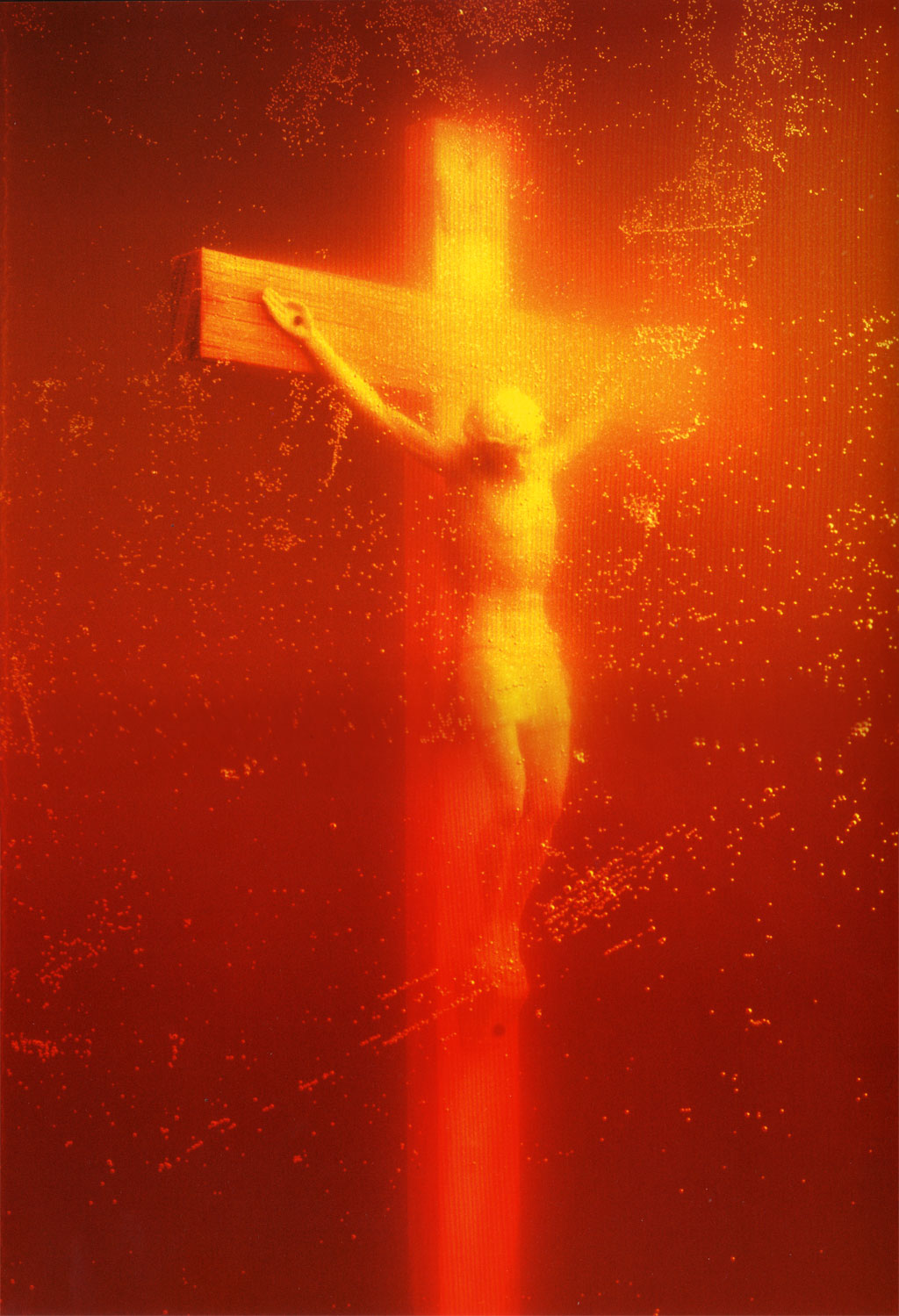This first ran at Comixology.
________
Comics has something of a chip on its shoulder about visual art — a kind of forthright working-nerd philistinism. The snooty, pasty theory-spouting degenerate sticks a flag in a cow turd and gets the grant and the girl while the hard-working illustrator who’s got pen technique like Durer gets a condescending pat on the head and relegation to a cultural backwater. Not only does the emperor have no clothes, but he is actually getting paid to paint his ugly genitals purple.
One of the more infamous art frauds of the last twenty years or so is Andres Serrano’s “Piss Christ.” Like most people, probably, I heard about “Piss Christ” before I saw it. From news accounts, I thought it was a plastic crucifix stuck in a jar of the artist’s urine. Jesse Helms hated it, and I had to admit that it seemed like he might have a point. It was easy to assume that Serrano was a trouble-making, glory-seeking hack, whose work was defensible only on the most extreme free-speech grounds. He seemed like a charlatan, substituting a gimmick, pretension, and contempt for genius.
I did actually see the piece in person many years later —a definite moment of “doh!” “Piss Christ” isn’t actually a plastic crucifix in urine, but a photograph of a plastic crucifix in urine. And the photograph is beautiful — the blurry cross shines with yellows, oranges and reds as mysterious bubbling currents swirl around it. Looking at the image without any background information, there’s no question that it is religious; an evocation of the mystery of Christ, who seems to be falling through space, cast aside and yet radiant. If you didn’t have the title, you wouldn’t even know the liquid was urine.

But, of course, viewers do have the title, as well as the background information, all of which rather changes things. Placing Christ in a jar of your own urine is an act of deliberate sacrilege. Serrano is pissing on God; humiliating him and mocking his humiliation. If you’re a Christian, it’s literally Satanic; Serrano might as well just affix the crown of thorns himself while sneeringly declaring “Hail, King of the Jews!”
The thing is that, as the crown of thorns itself suggests, mocking Christ is itself scriptural. The Passion is about degradation and defilement. Christ is mocked, brutalized, humiliated — and then redeemed. The sacred can’t exist without the profane; you need the leaking bodily fluids and the rotting husk if you are to have the transubstantiation. Christ must be reduced to the lowest of the low, to an abject thing, to a place where the body is everything, before the body can become nothing at all. If urine squicks you out, it’s worth remembering that Christ embraced the lepers. And as for Jesse Helms…given his stance on AIDS, he would have been much less likely to hug a leper than to piss on one.
Not to be too hard on Helms who is, after all, not the only sinner in the room. If Christianity urges its followers to sympathize with the tortured, it is also quite aware that most people are a good bit more comfortable identifying with the torturer. “Piss Christ” may be sneering at Christ, but it is also, and certainly, sneering at those who profess to follow him. Helms accused Serrano of “taunting the American people,” which is about right. He was, specifically, taunting them for being crassly commercial, spiritual hypocrites — for being sinners. And as long as there are sinners, Christ will be defiled.
Nobody wants to be called a Christ-killer, and it’s little wonder that Serrano’s work has…er… pissed people off. An outraged Helms declared that Serrano “is not an artist. He is a jerk.” While I appreciate the charming forthrightness, I think the sentiment is maybe a little limiting. Why can’t you be an artist and a jerk?
Indeed, there are a lot of artists who make their living by being jerks. They’re called political cartoonists. Like Serrano, they use a combination of words, images and instantly recognizable symbols to make moral points, and like Serrano, they do it in a way designed to irritate as many people as possible. From “Piss Christ” to the Danish Mohammad cartoons just isn’t that big a step (as I am not the first to note: for instance, the ever-helpful Wikipedia even provides a link from the first to the second.)
“Piss Christ” is different in some ways from most editorial cartoons, of course. For one thing, the way it juxtaposes image and text is a lot more thoughtful than you’re likely to see sitting above the op-eds. Most editorial cartoons are visual one-liners with notes — that’s the Democratic Party; this is the Republican party; they don’t like each other! Ha ha. Serrano, on the other hand, uses words to change the way you see the image, and to alter what it’s saying to you. The distance between religious and sacrilegious turns around the title — and it’s not just one turn either. As in any good editorial cartoon, the message is definitely “fuck you,” but who is being fucked with and why is both ambivalent and mysterious. Even the aesthetics of the piece are translated back into a legible text; “Piss Christ” is actually about its own beauty, and about the way that beauty is ironicized by, or transcends, the title.
The point here isn’t “Editorial cartoons should be more like ‘Piss Christ!” For one thing, Jesse Helms is safely dead, and I don’t particularly want him rising from his grave to wreak vengeance. But it does seem to me that dismissing large swaths of the visual arts tradition as irrelevant fakery is an unfortunate and impoverishing road to take. If comics creators are interested in the interaction between words and images, then Andres Serrano surely has something to say to them.


